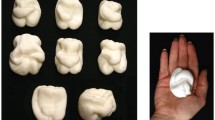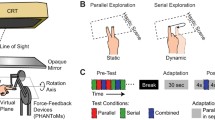Abstract
The human ability to recognize objects on the basis of their shape, as defined by active exploratory movements, is dependent on sensory feedback from mechanoreceptors located both in the skin and in deep structures (haptic feedback). Surprisingly, we have little information about the mechanisms for integrating these different signals into a single sensory percept. With the eventual aim of studying the underlying central neural mechanisms, we developed a shape discrimination test that required active exploration of objects, but was restricted to one component of shape, two-dimensional (2D) angles. The angles were machined from 1-cm-thick Plexiglas, and consisted of two 8-cm-long arms that met to form an angle of 90° (standard) or 91° to 103° (comparison angles). Subjects scanned pairs of angles with the index finger of the outstretched arm and identified the larger angle of each pair explored. Discrimination threshold (75% correct) was 4.7° (range 0.7° to 12.1°), giving a precision of 5.2% (0.8–13.4%: difference/standard). Repeated blocks of trials, either in the same session or on different days, had no effect on discrimination threshold. In contrast, the motor strategy was partly modified: scanning speed increased but dwell-time at the intersection did not change. Finally, 2D angle discrimination was not significantly modified by rotating the orientation of one of the angles in the pair (0°, 4° or 8° rotation towards the midline, in the vertical plane), providing evidence that subjects evaluated each angle independently in each trial. Subject reports indicated that they relied on cutaneous feedback from the exploring digit (amount of compression of the finger at the angle) and mental images of the angles, most likely arising from proprioceptive information (from the shoulder) generated during the to-and-fro scans over the angle. In terms of shoulder angles, the mean discrimination threshold here was 0.54° (range 0.08° to 1.36°). These values are lower than previous estimates of position sense at the shoulder. In light of the subjects’ strategies, it therefore seems likely that both cutaneous and proprioceptive (including both dynamic and static position-related signals) feedback contributed to the haptic discrimination of 2D angles.
Similar content being viewed by others
Author information
Authors and Affiliations
Corresponding author
Rights and permissions
About this article
Cite this article
Voisin, J., Benoit, G. & Chapman, C.E. Haptic discrimination of object shape in humans: two-dimensional angle discrimination. Exp Brain Res 145, 239–250 (2002). https://doi.org/10.1007/s00221-002-1117-6
Received:
Accepted:
Published:
Issue Date:
DOI: https://doi.org/10.1007/s00221-002-1117-6




